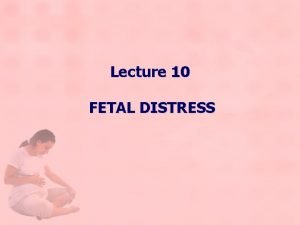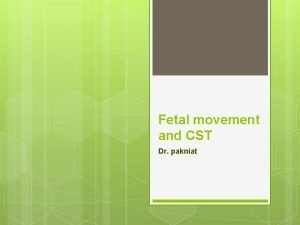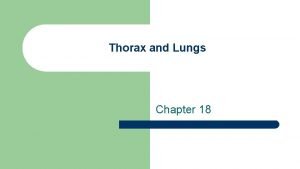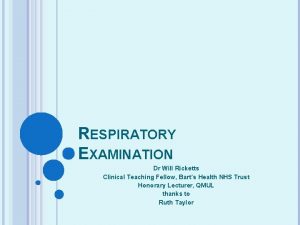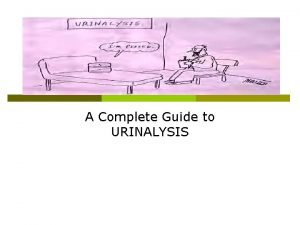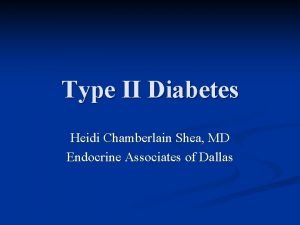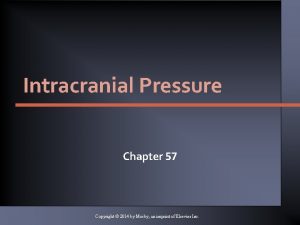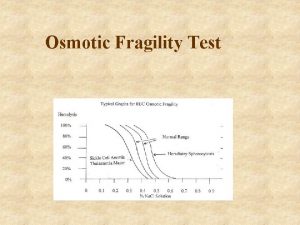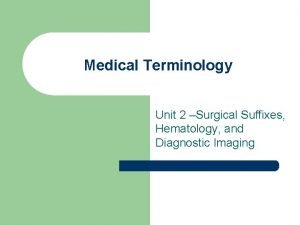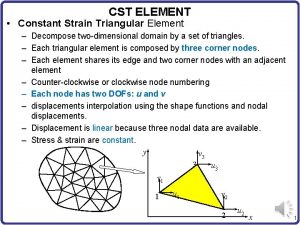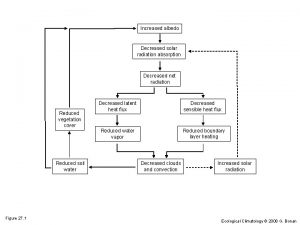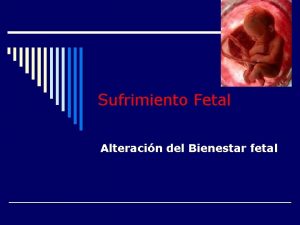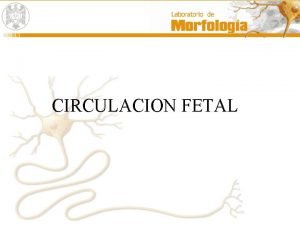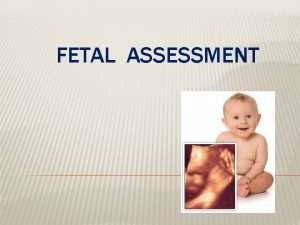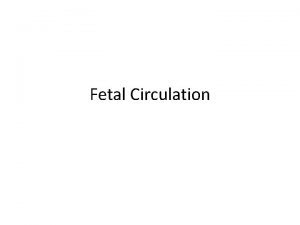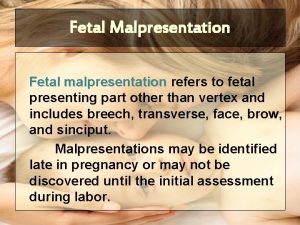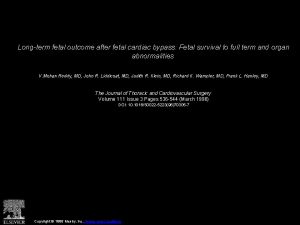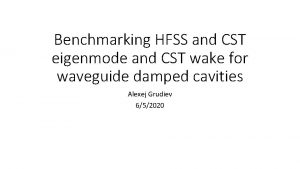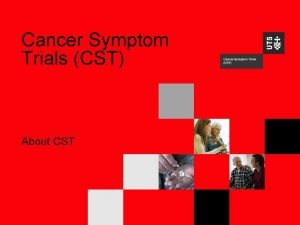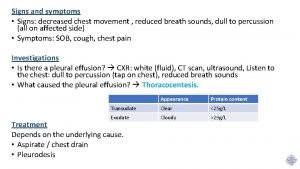Fetal movement and CST Dr pakniat Decreased fetal



























- Slides: 27

Fetal movement and CST Dr. pakniat

Decreased fetal movement: Diagnosis, evaluation, and management

INTRODUCTION Maternal perception of fetal movement is reassuring for pregnant women, while decreased fetal movement (DFM) is a common reason for concern. While an active fetus is a reassuring sign that the fetus is alive and in good condition, the use of fetal kick counting as a fetal surveillance tool has not achieved widespread acceptance. This is, in part, because optimal methods of diagnosis, evaluation, and management of DFM have not been determined.

NORMAL FETAL MOVEMENT Sonographically, fetal activity can be noted as early as 7 to 8 weeks of gestation. Maternal perception of fetal movement typically begins in the second trimester at around 16 to 20 weeks of gestation and occurs earlier in parous women than nulliparous women. The mother's first perception of fetal movement, termed "quickening, " is often described as a gentle flutter.

In the second and third trimesters, sonography reveals a wide range of movements of the fetal trunk (eg, bending, startle, hiccup, breathing, rotation), limbs (eg, stretch, hand to face, opening and closing of hands), and face and head (eg, head rotation, suck, yawn). When sonographically detected movements were correlated with maternal perception, approximately 50 percent of isolated limb movements were perceived by the mother In a literature review, mothers perceived 33 to 88 percent of sonographically visualized fetal movements.

Fetal movement increases throughout day, with peak activity late at night. The frequency of fetal movement in normal pregnancy is probably constant throughout the third trimester , however, the quality of perceived movements changes. Although some studies report that fetal activity normally decreases near term, this is likely due to counting during fetal quiet cycles, which become longer with advancing gestation, or inclusion of high-risk pregnancies.

PREVALENCE OF DECREASED FETAL MOVEMENT: At least 40 percent of pregnant women become concerned about DFM one or more times during pregnancy. Most cases are transient. Four to 15 percent of pregnant women will contact their care provider because of persistent DFM in the third trimester.

PATHOPHYSIOLOGY AND SIGNIFICANCE Normal quantity and quality of fetal movement and other types of fetal biophysical activity (breathing movements, tone) virtually ensures functional integrity of fetal regulatory systems. When these regulatory systems are subjected to mild hypoxemia, DFM is believed to represent a compensatory fetal behavioral response, analogous to the compensatory physiological response of redistribution of blood flow to essential organs. As hypoxemia becomes more severe and prolonged, compensatory responses may fail to protect the fetus, eventually leading to fetal injury or death. Early recognition of DFM may provide an opportunity for identifying fetuses that may be compromised and could benefit from intervention, usually delivery, and thereby prevent possible progression to fetal/neonatal injury or death

DIAGNOSIS OF DECREASED FETAL MOVEMENT Although there is no consensus on diagnosis of DFM, we consider qualitative (subjective) maternal perception of a reduction of fetal movement diagnostic. The best diagnostic criteria are controversial because the level of fetal movement that reliably distinguishes a healthy fetus from a fetus at increased risk of adverse outcome has not been determined.

Our approach : In the third trimester, we base the diagnosis of DFM upon qualitative (subjective) maternal perception of a reduction of fetal movement. We inform patients that their perception of fetal movement is a significant indicator of fetal wellbeing and they should pay attention to this activity daily to enable timely detection of DFM. They are instructed to contact their healthcare provider for further evaluation if they perceive a significant and persistent reduction in fetal movement and never to wait longer than two hours if there is absent fetal movement.

Some patients and providers prefer to use a form for documenting daily movements. Forms provide an ongoing record of fetal movement for day-today and week-to-week comparisons. In the second trimester, the prevalence and significance of DFM are largely unknown. We believe a prudent and pragmatic approach is for women over 24 weeks of gestation to contact their provider if they perceive a significant and persistent reduction in fetal movement from baseline, similar to the approach in the third trimester. If a woman presents with DFM before 24 weeks of gestation, she should undergo routine antenatal evaluation, including auscultation for the fetal heartbeat.

Kick counts : Kick counts are a quantitative alternative to our qualitative approach to assessment of fetal activity. The minimum number of maternally perceived fetal movements consistent with fetal well-being has been termed the "alarm limit. “ Various methods for defining an alarm limit have been proposed. The following are four examples of thresholds for reassurance of fetal well-being: ●Perception of least 10 fetal movements (FMs) over up to two hours when the mother is at rest and focused on counting ("count to 10" method) ●Perception of at least 10 FMs during 12 hours of normal maternal activity ●Perception of at least 4 FMs in one hour when the mother is at rest and focused on counting ●Perception of at least 10 FMs within 25 minutes in pregnancies 22 to 36 weeks and 35 minutes in pregnancies 37 or more weeks of gestation

DIFFERENTIAL DIAGNOSIS: Transient decreases in fetal activity can be due to fetal sleep states, maternal medications that cross the placenta (eg, sedatives), or maternal smoking. Fetal sleep is a common and benign cause of DFM. Sleep cycles may last up to 40 minutes.

Poor maternal perception of fetal activity is another reason for maternal report of DFM. It may be due to: -early gestational age, -decreased/increased amniotic fluid volume, -maternal position (sitting or standing versus lying), -fetal position (anterior position of the fetal spine), -anterior placenta, -obesity, - maternal physical activity, or the mother just being mentally distracted.

EVALUATION : Clinical approaches described in observational studies include: physical examination, nonstress or contraction stress tests, ultrasound examination (biophysical profile [BPP]), umbilical artery Doppler, testing for fetomaternal hemorrhage (eg, Kleihauer-Betke test), and amnioscopy. The wide range of diagnostic approaches reflects efforts to detect acute and chronic fetal hypoxemia and other fetal pathologies (eg, infection, neuromuscular disease) associated with DFM. The goal of the evaluation is to rule out imminent fetal demise and to try to determine the cause of DFM, such as fetal growth restriction with decreasing placental function. A plan of care is formulated based on the results of the evaluation

Initial evaluation : We suggest the following basic initial evaluation: ●Fetal viability should be determined by documenting the fetal heart rate. After fetal demise, the mother may attribute passive intrauterine motion or intestinal activity to fetal movement. ●The prenatal record should be reviewed for maternal medical or obstetrical conditions and characteristics that place the fetus at increased risk of adverse outcome. ●A nonstress test (NST) is performed and provides immediate information about fetal well-being.

Ultrasound examination : If the NST is reactive, we believe that ultrasound examination is a valuable additional tool for assessment of pregnancies complicated by persistent DFM, and is reassuring for mothers. Ultrasound examination is performed within 24 to 48 hours to reassess fetal well-being unless the patient reports that the fetus is active and “back to normal” after a reactive nonstress test. Ultrasound examination should include assessment of fetal activity, breathing, tone, and amniotic fluid volume, as well as fetal growth and anatomic survey if not recently performed. Growth restriction has been associated with a decrease in the number, quality, strength, and duration of fetal movements and repeated episodes of DFM at term.

Doppler velocimetry : Doppler velocimetry is restricted to pregnancies in which fetal growth restriction has been identified on ultrasound examination, as no benefit has been demonstrated with routine examination of all pregnancies with DFM.

Testing for fetomaternal transfusion: We suggest performing a maternal assay (Kleihauer-Betke stain or flow cytometry) to detect fetomaternal hemorrhage as part of the evaluation of the pregnant woman who presents with both DFM and signs of fetal anemia, such as a sinusoidal fetal heart rate pattern, unexplained fetal tachycardia, or fetal hydrops on ultrasound examination associated with elevated middle cerebral artery Doppler velocity.

PREGNANCY MANAGEMENT: A 2012 systematic review concluded no data from randomized trials was available to guide practice recommendations for management of DFM. Findings at the initial evaluation guide our approach to subsequent management, which is based on data from observational studies of pregnancies with DFM and pregnancies with medical or obstetrical complications associated with a high risk of adverse outcome.

Nonreactive nonstress test, low biophysical profile score, fetal growth restriction : These abnormal findings are managed according to usual clinical standards. ●Return of normal fetal activity and normal evaluation : Women who experience a brief period of DFM followed by resumption of normal fetal activity during fetal evaluation and a normal evaluation can resume routine prenatal care. They are instructed to continue to monitor fetal movement and call their provider if they perceive recurrent persistent DFM.

Persistent DFM and normal fetal evaluation: No studies have evaluated the optimal frequency and method of follow-up of pregnancies complicated by persistent DFM in which the antepartum evaluations discussed above are normal. Our approach depends on whether the pregnancy has reached term and whether additional maternal or fetal risk factors for adverse outcome are present. we believe repeated evaluation or delivery is important in managing pregnancies with persistent DFM and an initially normal evaluation (including objective observation of fetal activity equivalent to a biophysical profile score ≥ 8). For pregnancies <37 weeks of gestation, we perform nonstress testing and ultrasound examination twice weekly and instruct patients to call their provider if they perceive a further decrease or absence of fetal movemen

We discuss the advantages and disadvantages of continued antepartum evaluation but suggest induction after 37 weeks, especially if there additional risk factors for adverse outcome.

Contraction stress test : For the CST, either a dilute oxytocin solution is infused or nipple stimulation is performed until three contractions occur within 10 minutes. There is no standard technique for nipple stimulation. The patient gently massages the nipple of one breast through her clothes for two minutes, stopping with onset of contractions; stimulation is resumed if contractions are too infrequent for CST interpretation. Both nipples can be stimulated if no contractions occur. In women who are having spontaneous contractions of adequate frequency, oxytocin or nipple stimulation is unnecessary.

Relative contraindications : to stimulating contractions for a CST are conditions that are also contraindications to labor and vaginal delivery placenta previa, vasa previa, previous classical cesarean delivery or extensive uterine surgery. Preterm labor, patients at high risk for preterm delivery, preterm premature rupture of membranes are also relative contraindications

The CST is interpreted as follows : ●Positive – A positive (nonreassuring) test has late decelerations following ≥ 50 percent of contractions. The test is positive even if the contraction frequency is less than three in 10 minutes. ●Negative – A negative (reassuring) test has no late decelerations or significant variable decelerations. ●Equivocal – An equivocal-suspicious test has intermittent late decelerations or significant variable decelerations equivocal-tachysystolic has decelerations with contractions occurring more frequently than every two minutes or lasting longer than 90 seconds ●Unsatisfactory – An unsatisfactory test is uninterpretable or fewer than three contractions in 10 minutes

The presence or absence of accelerations is also generally noted. For example, a reactive positive CST is a FHR tracing that meets criteria for both a reactive NST and a positive CST. Positive contraction stress test : A positive (nonreassuring) CST may indicate fetal hypoxemia. An equivocal-suspicious test with repetitive variable decelerations is also associated are often related to cord compression due to oligohydramnios, especially with postterm pregnancy. Because of the CST’s high false-positive rate (>60 percent), FHR reactivity during the test is used to differentiate false-positive tests (an intrapartum FHR not requiring intervention) from true-positive tests (an abnormal intrapartum FHR requiring intervention).
 Fetal distress definition
Fetal distress definition Causes of decreased fetal movement
Causes of decreased fetal movement Tactile fremitus increased
Tactile fremitus increased What is tactile fremitus
What is tactile fremitus Increase tactile fremitus
Increase tactile fremitus Pneumonia and tactile fremitus
Pneumonia and tactile fremitus Decreased breath sound
Decreased breath sound 4 times a number cubed decreased by 7
4 times a number cubed decreased by 7 Normal specific gravity of urine
Normal specific gravity of urine Decreased glucose
Decreased glucose Nursing diagnosis for ngt feeding
Nursing diagnosis for ngt feeding Z score formula
Z score formula Decreased intracranial adaptive capacity nursing diagnosis
Decreased intracranial adaptive capacity nursing diagnosis Sglt2 inhibitors comparison chart
Sglt2 inhibitors comparison chart Tactile fremitus vs vocal fremitus
Tactile fremitus vs vocal fremitus As the value of roman coins decreased people began to
As the value of roman coins decreased people began to Describe osmotic fragility test
Describe osmotic fragility test Decreased osmotic fragility
Decreased osmotic fragility Venus vs earth
Venus vs earth Decreased contractility
Decreased contractility Graph suffix medical terminology
Graph suffix medical terminology Movement area
Movement area What is locomotor dance
What is locomotor dance Cst stands for
Cst stands for Cst training program
Cst training program Ansys cst
Ansys cst Stiffness matrix for cst element
Stiffness matrix for cst element Cst
Cst
